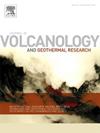安山质平原火山爆炸活动前的导管铠装,新西兰塔拉纳基蒙加的一个例子
IF 2.4
3区 地球科学
Q2 GEOSCIENCES, MULTIDISCIPLINARY
Journal of Volcanology and Geothermal Research
Pub Date : 2024-11-01
DOI:10.1016/j.jvolgeores.2024.108214
引用次数: 0
摘要
火山导管的强度和渗透性可通过调节上升岩浆的排气和喷发羽流的密度直接影响喷发动力学。火成碎屑喷出物中的碎石可用于了解导管壁的动态演化,因为它们在火山喷发过程中被纳入上升的熔融-气体-颗粒混合物中。我们研究了公元 1655 年塔拉纳基蒙加的伯利尔喷发,这次喷发从喷出活动过渡到了亚普林期的爆炸阶段,并以不稳定柱状结束。在这次喷发之后,又发生了一系列爆炸性较低的喷出式喷发。通过纹理分析和物理性质,我们区分了布瑞尔沉积物中的五种主要碎屑岩类型,它们代表了浅层导管和喷口的不同区域。1-3 类岩石代表幼年("侵入同源物")和较老("侵入附属物")的导管填充塞材料。第 4 类岩石代表喷发初期挤出的幼年("挤出同源物")喷口填充熔岩穹丘,而第 5 类岩石("挤出同源物")则代表浅喷口在喷发方式转变期间积累的烧结/压实同源物。结晶安山岩岩屑(类型 1)显示出以微岩为主的地层。经热液蚀变的安山岩岩屑(类型 2)与类型 1 的岩屑相比,显示出表晶的破碎和地震速度的增加。碎屑安山岩岩屑(第 3 类)由碎裂和烧结的结晶安山岩碎屑组成。玻璃质安山岩岩屑(第 4 类)显示出亚圆形泡状体和玻璃质微晶。带状闪长岩(第 5 类)显示出不同泡状、结晶度和碎屑负荷的带状。物理性质数据显示,孔隙度、断裂、烧结和蚀变程度决定了导管渗透性和潜在强度的动态变化。我们的研究结果表明,在布瑞尔火山爆发的爆炸阶段,导管内有幼年和残余的浅层堵塞材料,这些材料在被侵蚀和喷出之前发生了不同程度的断裂、烧结和蚀变。与以前在塔拉纳基进行的研究以及世界各地的穹顶岩塞材料进行的比较表明,导管壁的断裂和烧结,加上内衬致密的幼体材料,是如何导致整体渗透性降低和导管加固的。这就抑制了排气,保护了导管结构,有利于向爆炸活动过渡和建立稳定的喷发柱。本文章由计算机程序翻译,如有差异,请以英文原文为准。
Conduit armouring preceding explosive activity at an andesitic stratovolcano, an example from Taranaki Mounga, New Zealand
The strength and permeability of volcanic conduits can directly influence eruption dynamics via moderating the outgassing of ascending magma and the density of eruption plumes. Lithic clasts in pyroclastic ejecta can be used to understand the dynamic evolution of conduit walls because they are incorporated into the ascending melt-gas-particle mixture during volcanic eruptions. We examine the 1655 CE Burrell eruption of Taranaki Mounga, which transitioned from effusive activity to an explosive sub-Plinian phase and ended in unsteady columns. This episode was followed by a series of effusive eruptions of lower explosivity. Using textural analysis and physical properties, we distinguish five dominant lithic clast types within Burrell deposits that represent different regions of the shallow conduit and vent. Lithic types 1–3 represent juvenile (‘intrusive cognate’) and older (‘intrusive accessory’) conduit-filling plug materials. Lithic type 4 represents juvenile (‘extrusive cognate’) vent-filling lava dome extruded at the eruption onset, while Type 5 lithics (‘extrusive cognate’) represent sintered/compacted cognate material from the shallow vent accumulated during transitions in eruptive style. Crystalline andesite lithics (type 1) show a microlite-dominated groundmass. Hydrothermally altered andesite lithics (type 2) show breakdown of phenocrysts and increased seismic velocity relative to type 1 lithics. Brecciated andesite lithics (type 3) comprise fractured and sintered clasts of crystalline andesite. Glassy andesite lithics (type 4) show sub-rounded vesicles and glass-hosted microlites. Banded vitrophyre lithics (type 5) show bands of varying vesicularity, crystallinity and clast load. Physical property data reveals porosity, fracturing, sintering and alteration extent dictate dynamic changes in conduit permeability and potentially strength. Our results show how, during the explosive phase of the Burrell eruption, the conduit was lined with juvenile and remnant shallow plug material that was variably fractured, sintered and altered before being eroded and ejected. Comparison with previous work on Taranaki and dome-plug material from around the world shows how fracturing and sintering of conduit walls, combined with lining with dense juvenile material, cause overall permeability reduction and strengthening of the conduit. This inhibits outgassing and preserves conduit structure, facilitating the transition to explosive activity and the establishment of a stable eruption column.
求助全文
通过发布文献求助,成功后即可免费获取论文全文。
去求助
来源期刊
CiteScore
5.90
自引率
13.80%
发文量
183
审稿时长
19.7 weeks
期刊介绍:
An international research journal with focus on volcanic and geothermal processes and their impact on the environment and society.
Submission of papers covering the following aspects of volcanology and geothermal research are encouraged:
(1) Geological aspects of volcanic systems: volcano stratigraphy, structure and tectonic influence; eruptive history; evolution of volcanic landforms; eruption style and progress; dispersal patterns of lava and ash; analysis of real-time eruption observations.
(2) Geochemical and petrological aspects of volcanic rocks: magma genesis and evolution; crystallization; volatile compositions, solubility, and degassing; volcanic petrography and textural analysis.
(3) Hydrology, geochemistry and measurement of volcanic and hydrothermal fluids: volcanic gas emissions; fumaroles and springs; crater lakes; hydrothermal mineralization.
(4) Geophysical aspects of volcanic systems: physical properties of volcanic rocks and magmas; heat flow studies; volcano seismology, geodesy and remote sensing.
(5) Computational modeling and experimental simulation of magmatic and hydrothermal processes: eruption dynamics; magma transport and storage; plume dynamics and ash dispersal; lava flow dynamics; hydrothermal fluid flow; thermodynamics of aqueous fluids and melts.
(6) Volcano hazard and risk research: hazard zonation methodology, development of forecasting tools; assessment techniques for vulnerability and impact.

 求助内容:
求助内容: 应助结果提醒方式:
应助结果提醒方式:


